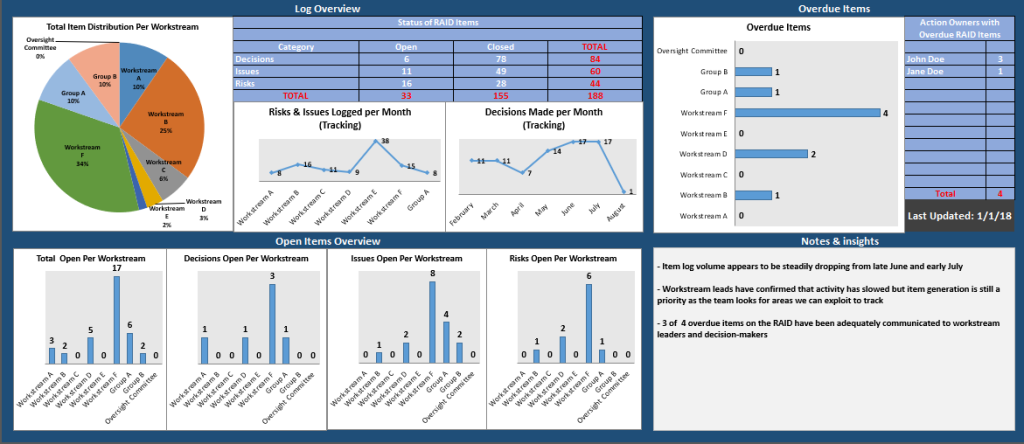Insight Paper January 8, 2019
Taking Your RAID Log to the Next Step With Analytics
Add quantitative insight to a key project management tool.
The RAID (Risks, Assumptions (or Action Items), Issues, Dependencies (or Decisions)) tool is a project management tracking deliverable that allows a team to quantify and display deadlines and impediments throughout the lifecycle of an engagement. A well-constructed and updated RAID can enable your team to see potential forthcoming issues in project-delivery milestones, document-delivery concerns, and backtracking insight on executive decisions that were previously made audibly or in meetings. It is an excellent “paper trail” resource that exemplifies the effort and progress a team has made or is currently making in the project. Not only does it provide crucial information for your engagement sponsors, it also assists in the onboarding of new team members or client-side personnel. While managing and maintaining the accuracy of a RAID on a multimillion-dollar engagement often feels like a full-time job, there are ways to present and promote the RAID log to business owners and project leaders in convincing ways that better align with the RAID’s intended purpose. Analytics, in this case, can play a pivotal role in expressing the health and status of your RAID log while additionally displaying areas for improvement.
Most RAIDs are housed in an Excel document or within a client’s specialized online portal, such as a SharePoint site. It can be difficult to convince project managers, business leaders, or technical leaders to navigate to the RAID document and sift through, in some cases, 100+ rows in an Excel workbook looking for a specific action item or currently tracked risk within their project domain. Filtering in Excel can alleviate this, but the broader picture is often more important. Utilizing analytics can help drive stakeholder interest and engagement while still providing necessary visibility into project statuses and specific action items or workstream metrics.

RAID INSIGHTS
While most RAID logs will have a common set of key metrics, each owner should consider tailoring tracked data according to the project’s standards and industry. For example, project leaders for a healthcare engagement may want to add a column for “Clinical Subject Matter Expert,” or a financial services engagement may contain a column capturing currency acronyms. Each RAID log should be unique. As a place to start, however, the following is a list of common data elements that are important to consider when creating your RAID (order/level of importance is up to your discretion):
- Workstream: The project path or division responsible for the RAID item
- Title: A brief phrase to accurately describe the item (especially useful when searching the document)
- Description: Should be no longer than two sentences and include the synopsis of the issue and what the current state is (i.e. Jane Doe is working on gathering requirements)
- (Content) Type: List if this is a Risk, Issue, Action Item, or Decision
- Status: Indicate whether the item is open (pending conclusion), closed (conclusion met and finalized), or, in some cases, resolved (reopened item is now closed)
- Priority: Is this considered a low, medium, high, or critical level of importance related to the item’s urgency in concluding
- Impact: Subjective numeric (usually 1 to 10) ranking of how impactful this item is to the project
- Assigned To: Name of individual or group that are responsible for providing clarity on the item or closing it
- Target Date: Solidified date of when the item should be closed by
- Close Date: Date the item was officially closed by the decision-makers (not the date the owner closed it in the RAID)
- Decision By: Point of reference or name of individual who was responsible for closing the item (may differ from “Assigned To”)
- Date Identified: Date of when the item was brought up for inclusion in the RAID or in conversation about the project (not the date it was inputted into the log)
- Comments: Though not advised as you want to keep the RAID professional and “to-the-point”, the owner can use this column to communicate ad-hoc issues or non-project management language, such as “John Doe on vacation for two weeks and item won’t be addressed until he gets back”
While using the above data elements in an Excel workbook, the RAID log owner could construct visual relationships and information graphs to accompany the quantitative elements of the log. Below are several metrics you could employ that will help you capture your RAID Log’s true value:
- Total open items per workstream
- Total open items vs. total closed item
- Ratio of open vs closed items
- Number of R, A, I, D per workstream or status (open/closed)
- Number of overdue items
- RAID log entry distribution per workstream
- Number of items due in the forthcoming weeks or a specific project deadline
- Log volume record by month or week of project
- Number of items owned by project management/business/tech team
- Distribution of items percentage to each owner
- Number of items owned by each owner

The way you display your data has a direct impact on the perception of its value. Strategically placing charts, or, contrarily, including too many, has influence over the reader’s attention span and value-added feedback. In addition, selecting the right style of a chart provides immense help in drawing out RAID statuses. For example, pie charts are excellent tools for displaying distributions. Bar charts would be ideal for showing quantified sums, such as number of items logged per workstream. Scatter charts or line graphs are best utilized when breaking down large volumes of information across the project’s lifetime, such as number of entries logged per a particular week or month. Furthermore, if the visuals are helpful to the project management team and others, individuals can take out portions of your dashboard for their deliverables. An example may be a Scrum Master copying and pasting your overdue item distribution pie chart for their monthly status PowerPoint deck. Or, a senior leader may want to utilize one of your bar charts displaying a list of workstream risks, so they can influence certain business or technology leaders to get moving on an action item.
The RAID log, without the analytics, is simply a central repository of information. A RAID log with analytics, however, is a visual centerpiece that communicates a story about your project. In an Excel RAID log, you could have three tabs, for example: (1) Visual dashboard, (2) RAID log, (3) Worksheet deck. Using COUNTIFS, pivot tables, and SUMIFS formulas will help the owner automate the front tab dashboard. The worksheet deck can be an empty sheet where the owner creates customized visuals based on project leadership feedback and project management status or reporting decks. Along with being used in post-project auditing, the RAID is a critical tool that plays a major role in documenting and advertising change throughout your project’s lifespan.

